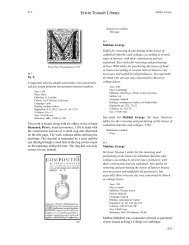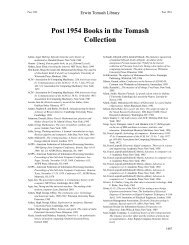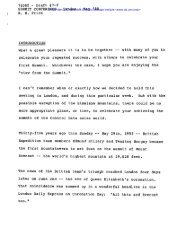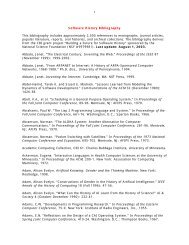B chapter.indd - Charles Babbage Institute - University of Minnesota
B chapter.indd - Charles Babbage Institute - University of Minnesota
B chapter.indd - Charles Babbage Institute - University of Minnesota
You also want an ePaper? Increase the reach of your titles
YUMPU automatically turns print PDFs into web optimized ePapers that Google loves.
it covers not only electronic stored program computers<br />
but also machines such as those constructed at Harvard<br />
by Aiken, relay computers built in Tokyo, British and<br />
European machines, and little-known projects such as<br />
the <strong>University</strong> <strong>of</strong> Toronto UTEC computer. No mention<br />
is made <strong>of</strong> the Zuse machines. Each entry gives technical<br />
details <strong>of</strong> the machine and short remarks that do not fit<br />
into any <strong>of</strong> the pre-assigned entry categories.<br />
156<br />
Illustrations available:<br />
Title page<br />
ERA 101 page<br />
Erwin Tomash Library<br />
Blackburn, John E. Blagrave, John<br />
B 173<br />
Blackburn, John E.<br />
Components handbook<br />
Year: 1949<br />
Place: New York<br />
Publisher: McGraw-Hill Book Company<br />
Edition: 1st<br />
Language: English<br />
Binding: original cloth boards<br />
Pagination: pp. xviii, 626<br />
Size: 230x145 mm<br />
B 172<br />
This is No. 17 in the Radiation Laboratory Series<br />
publications. It was intended as a reference work to<br />
accompany volumes 18–23 <strong>of</strong> the series. The volume was<br />
intended to be a broad survey <strong>of</strong> the field <strong>of</strong> electrical,<br />
mechanical and electronic components that were used<br />
by the Radiation Laboratory, but because <strong>of</strong> the decision<br />
to shut the Office <strong>of</strong> Publications, several <strong>chapter</strong>s were<br />
omitted. It represents a state-<strong>of</strong>-the-art survey <strong>of</strong> the<br />
technology in use at the time and includes everything<br />
from simple cables to elementary electronic devices,<br />
instrument motors, relays and vacuum tubes. It is heavily<br />
illustrated with photographs and diagrams <strong>of</strong> the devices<br />
as well as numerous tables giving characteristics and test<br />
results as determined by the Radiation Laboratory.<br />
Illustrations available:<br />
Title page<br />
B 174<br />
Blagrave, John (1558?–1612)<br />
B 173<br />
The mathematical jewel. Shewing the making, and most<br />
excellent use <strong>of</strong> a singuler instrument so called: in that<br />
it performeth with wonderfull dexteritie, whatsoever is<br />
to be done, either by quadrant, ship, circle, cylinder,<br />
ring, dyall, horoscope, astrolabe, sphere, globe, or any<br />
such like heret<strong>of</strong>ore devised: yea, or by most tables<br />
commonly extant: and that generally to all places from<br />
pole to pole.<br />
Year: 1585<br />
Place: London<br />
Publisher: Walter Venge<br />
Edition: 1st<br />
Language: English<br />
Figures: 3 engraved frontispiece plates; 2 engraved full-page<br />
tables<br />
Binding: contemporary limp vellum<br />
Pagination: pp. [16], 124<br />
Collation: 4 2 A–P 4 Q 2<br />
Size: 268x182 mm<br />
Blagrave was a mathematician, surveyor and instrument<br />
maker from Reading. Educated at St. John’s College,<br />
Oxford, he never took a degree but returned to Reading,<br />
where he lived <strong>of</strong>f the legacy <strong>of</strong> land left to him by his<br />
father. He left a legacy to the town <strong>of</strong> Reading (the sum<br />
<strong>of</strong> 20 nobles annually) to be competed for by three maid







